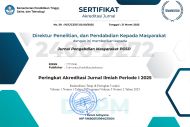Optimalisasi Google Workspace untuk Produktivitas dan Kesiapan Kerja Siswa Akuntansi di Sekolah Menengah Kejuruan
Abstract
Keywords
Full Text:
PDFReferences
Ayanwale, M. A., Molefi, R. R., & Liapeng, S. (2024). Unlocking educational frontiers: Exploring higher educators’ adoption of Google Workspace technology tools for teaching and assessment in Lesotho dynamic landscape. Heliyon, 10(9), e30049. https://doi.org/10.1016/j.heliyon.2024.e30049
Basri, W. S., Alandejani, J. A., & Almadani, F. M. (2018). ICT adoption impact on students’ academic performance: Evidence from Saudi universities. Education Research International, 2018, 1240197. https://doi.org/10.1155/2018/1240197
Bland, T., Guo, M., & Dousay, T. A. (2024). Multimedia design for learner interest and achievement: a visual guide to pharmacology. BMC Medical Education, 24(1), 113. https://doi.org/10.1186/s12909-024-05077-y
Buchan, M. C., Bhawra, J., & Katapally, T. R. (2024). Navigating the digital world: development of an evidence-based digital literacy program and assessment tool for youth. Smart Learning Environments, 11(1), 8. https://doi.org/10.1186/s40561-024-00293-x
Carretero, S., Vuorikari, R., & Punie, Y. (2017). DigComp 2.1: The digital competence framework for citizens with eight proficiency levels and examples of use. Publications Office of the European Union. https://doi.org/10.2760/38842
Cavanagh, T. M., & Kiersch, C. (2022). Using commonly-available technologies to create online multimedia lessons through the application of the Cognitive Theory of Multimedia Learning. Educational Technology Research and Development, 71(3), 1033–1053. https://doi.org/10.1007/s11423-022-10181-1
Durrani, N., Qanay, G., Mir, G., Helmer, J., Polat, F., Karimova, N., & Temirbekova, A. (2023). Achieving SDG 4, equitable quality education after COVID-19: Global evidence and a case study of Kazakhstan. Sustainability, 15(20), 14725. https://doi.org/10.3390/su152014725
Emilzoli, M.; Hernawan, A. H.; Rullyana, G.; Priandani, A. P. (2025). The role of Google Workspace in facilitating collaborative and participatory learning higher education. Journal of Education Technology, 9(1), 117–125. https://doi.org/https://doi.org/10.23887/jet.v9i1.84112
Govender, I. (2025). Digital literacy and STEM skills– what is the connection? A systematic review. Technology, Knowledge and Learning (Online First). https://doi.org/10.1007/s10758-025-09879-x
Habibi, M. W., Buditjahjanto, I. G. P. A., & Rijanto, T. (2024). Digital literacy ability of private vocational students in Surabaya City. Journal of Education and Learning, 18(3), 745–752. https://doi.org/10.11591/edulearn.v18i3.21104
Hadiyanto, H., Batubara, R., & Nawireja, I. K. (2025). Hubungan Karakteristik individu dan aksesibilitas terhadap internet dengan tingkat literasi digital di kalangan pemuda (Kasus: pemuda Desa Gunung Putri, Kecamatan Gunung Putri, Kabupaten Bogor). Jurnal Sains Komunikasi dan Pengembangan Masyarakat (JSKPM), 8(3), 28–39. https://doi.org/10.29244/jskpm.v8i03.1347
Haryani, J. (2023). Digital literacy: Classroom action research for vocational high school students’. Journal Evaluation in Education (JEE), 4(2), 40–45. https://doi.org/10.37251/jee.v4i2.315
Hattie, J. (2009). Visible learning: A synthesis of over 800 meta-analyses relating to achievement. Routledge. https://doi.org/10.4324/9780203887332
Hayat, A. A., Shateri, K., Amini, M., & Shokrpour, N. (2020). Relationships between academic self-efficacy, learning-related emotions, and metacognitive learning strategies with academic performance in medical students: A structural equation model. BMC Medical Education, 20(1), 76. https://doi.org/10.1186/s12909-020-01995-9
Jatmoko, D., Suyitno, S., Rasul, M. S., Nurtanto, M., Kholifah, N., Masek, A., & Nur, H. R. (2023). The factors influencing digital literacy practice in vocational education: A structural equation modeling approach. European Journal of Educational Research, 12(2), 1109–1121. https://doi.org/10.12973/eu-jer.12.2.1109
La Torre, S., & Désiron, J. C. (2024). From research to practice: Are Multimedia principles present in instructional videos used by teachers in science and history? Technology, Knowledge and Learning, 29(4), 1993–2016. https://doi.org/10.1007/s10758-024-09753-2
Laitinen, S., Christopoulos, A., Laitinen, P., & Nieminen, V. (2024). Relationships between self-efficacy and learning approaches as perceived by computer science students. Frontiers in Education, 9, 1181616. https://doi.org/10.3389/feduc.2024.1181616
Mayer, R. E. (2024). The past, present, and future of the cognitive theory of multimedia learning. Educational Psychology Review, 36, 8. https://doi.org/10.1007/s10648-023-09842-1
Ndibalema, P. (2025). Digital literacy gaps in promoting 21st century skills among students in higher education institutions in Sub-Saharan Africa: A systematic review. Cogent Education, 12(1), 2452085. https://doi.org/10.1080/2331186X.2025.2452085
Nurkhin, A., & Rohman, A. (2023). Using Google Workspace for education to engage accounting students. Jurnal Pendidikan Ekonomi dan Bisnis (JPEB), 11(1), 80–88. https://doi.org/10.21009/jpeb.011.1.7
Oliynyk, V. V., Gushchyna, N. I., Kondratova, L. H., & Kasian, S. P. (2024). Developing digital competence of teachers in postgraduate education using Google Workspace for Education. CTE Workshop Proceedings, 11, 356–380. https://doi.org/10.55056/cte.662
Pahayahay, A. (2025). Enhancing collaboration through Google Workspace: Assessing and strengthening current practices. International Journal of Computing Sciences Research, 9, 3602–3617. https://doi.org/10.25147/ijcsr.2017.001.1.235
Ramos-Pla, A., del Arco, I., Olondriz-Valverde, A., & Fornons Casol, L. (2025). Education and nursing in the 2030 agenda: Challenges and opportunities for university education. Sustainability, 17(6), 2757. https://doi.org/10.3390/su17062757
Waxman, J. B., & Goldie, S. J. (2023). The cognitive theory of multimedia learning. Perspectives from the CHDS Media Hub. https://chds.hsph.harvard.edu/
Swaramarinda, L., Isa, B. B., Puruwita, D., Faslah, R., Sebayang, K. D. A., & Adha, M. A. (2025). Preparing vocational students for the digital economy: Exploring the role of digital literacy, entrepreneurial agility, and digital entrepreneurship education. Social Sciences & Humanities Open, 12, 101926. https://doi.org/10.1016/j.ssaho.2025.101926
Tanjung, R. (2023). Peningkatan kompetensi guru melalui pemanfaatan Google Workspace for Education di SMPN 4 Tanah Merah. Instructional Development Journal, 6(1), 53. https://doi.org/10.24014/idj.v6i1.24621
Xu, J., Jiang, T., Wei, M., & Qing, Z. (2024). The digital transformation of vocational education: Experience and reflections of Shenzhen Polytechnic University. Vocation and Technology & Education, 1(2), 1–12. https://doi.org/10.1234/vte.2024.522
Zhang, Y., Qian, W., & Chen, C. (2024). The effect of digital technology usage on higher vocational student satisfaction: the mediating role of learning experience and learning engagement. Frontiers in Education, 9, 1508119. https://doi.org/10.3389/feduc.2024.1508119
DOI: https://doi.org/10.17509/jpm.v5i2.89630
Refbacks
- There are currently no refbacks.
Copyright (c) 2025 Universitas Pendidikan Indonesia

This work is licensed under a Creative Commons Attribution 4.0 International License.

Jurnal Pengabdian Masyarakat PGSD is licensed under a Creative Commons Attribution 4.0 International License.
This journal is indexed by

.png)



1.png)

1.png)


1.png)